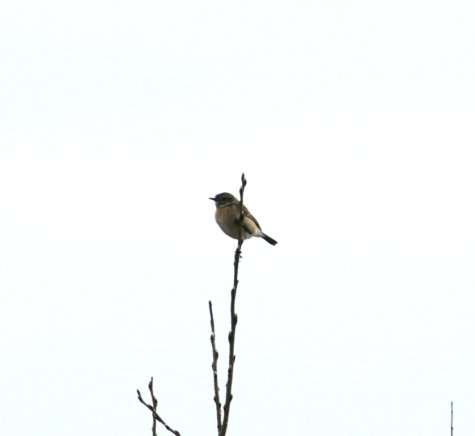Birder's diary - 20.04
Birder Margus Ots, Linnuvaatleja.ee
Translation: Liis
European stonechatEuroopa kaelustäks Saxicola rubicola
The rainy weather gave hope that many passerines would have landed from the migration. So once more I went to look around on the West Saaremaa shores. On Karala beach there wasn’t much to note however, but at Rahuste interesting creatures were to be seen again. Among the passerines downed from migration at least 2 Lapland longspurs were visible today too and as a pleasant surprise, a horned lark was busy among the larks. It is a rather rare passing migrant here but has been seen several times in Estonia this spring. Probably it might be seen more often in passing but we simply don’t particularly follow the passerine migration. This year migration projects happened to be running both at Kabli and Kihnu and immediately more observations came too. In Rahuste two horned larks had also been seen a few days ago. There is a chance that today’s bird is one of those observed earlier but most likely it is a new bird.
At Rahuste beach I found one more new species for my year list – in a watery spot a Jack Snipe flew up at my feet. Already a few days ago at Karala I noticed from the car two birds that seemed to be Jack Snipes taking flight barely a meter away but they disappeared before I got out of the car and the identity stayed open. This species too is primarily seen on migration, as nester it is rare here.
European stonechat, female (20.04.2012 Kabli).
On leaving Rahuste I had the choice of going straight back to Tartu or visiting Sõrve säär before heading for the mainland. The decision was made simple by the fact that just at the right moment information arrived that a European stonechat had been seen at the Kabli bird station. So I went to Tartu by way of Kabli. Reaching Kabli in the evening it turned out as good news that the stonechat had been moving around in the meadow in front of the bird station only a few hours ago. As it was raining very hard the stonechat didn’t show up immediately, evidently it was hiding somewhere in the bushes. After an hour of waiting more twitchers arrived, the rain stopped and the bird was back in its former place. Since the stonechat is quite shy I only caught a poor photo of it, a somewhat better one is in the e-Biodiversity data base. The European stonechat has only been seen 9 times earlier in Estonia according to the Bird rarities committee, so this is the 10th observation. For me it is my second observation in Estonia – in 2006 I managed to see a bird in exactly the same spot.
There are now 175 bird species in my 2012 species year list. This time the Saaremaa trip went very well indeed, I managed to see many interesting species: green woodpecker, ring ouzel, horned lark, twite, Lapland longspur, rock pipit, Jack Snipe and then on the road home, the hardest species of the trip, European stonechat. Mood is good, my “Big Year” proceeds at full speed.









